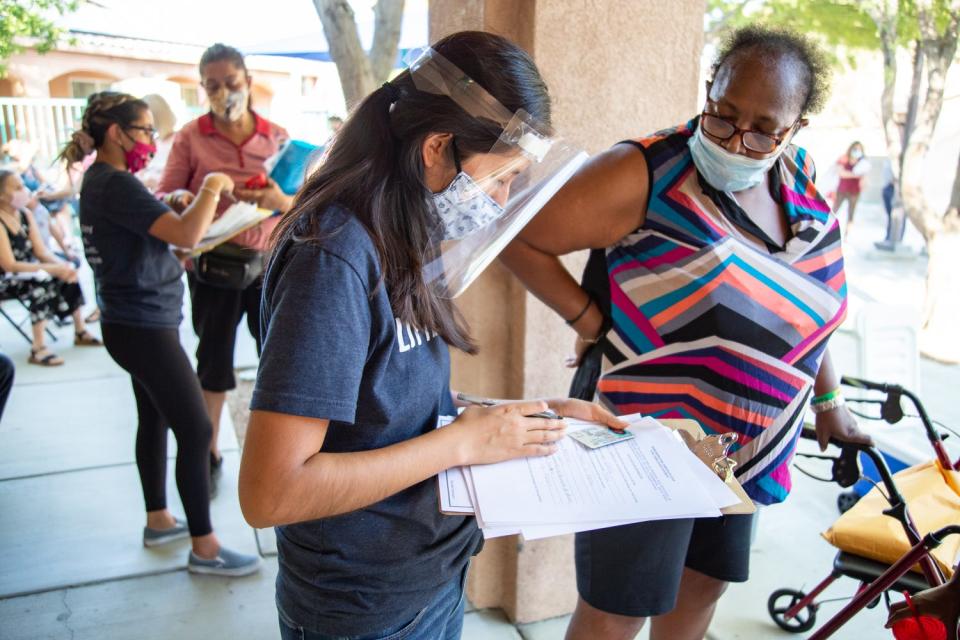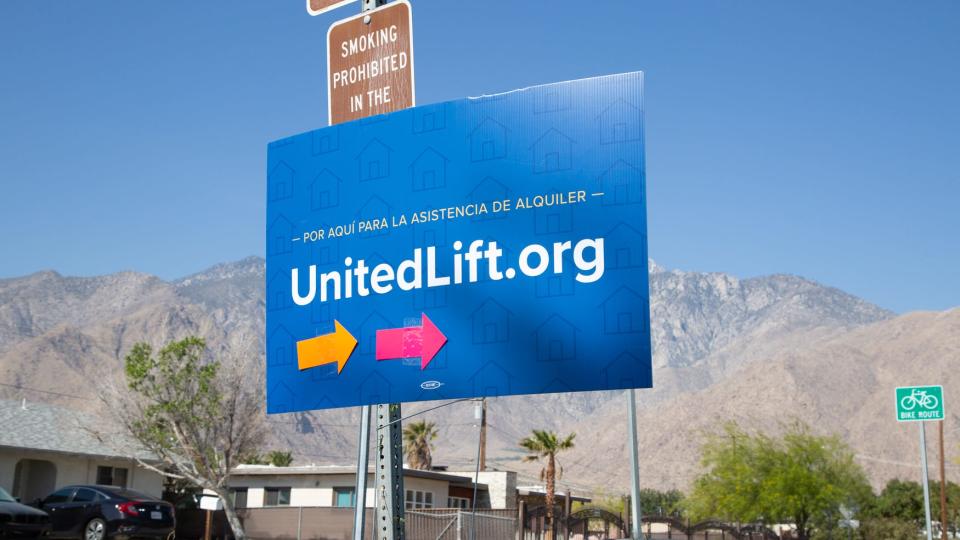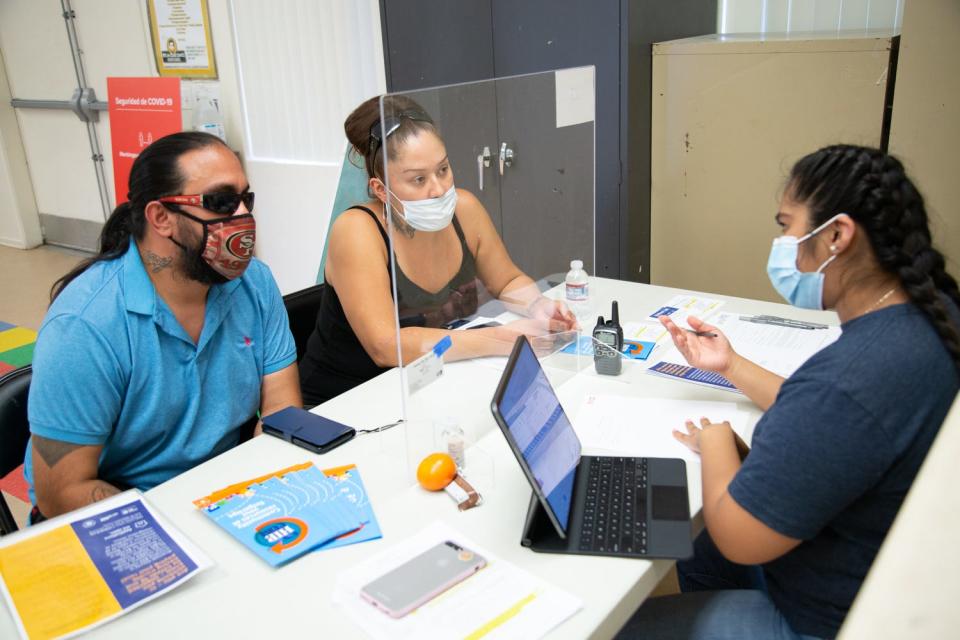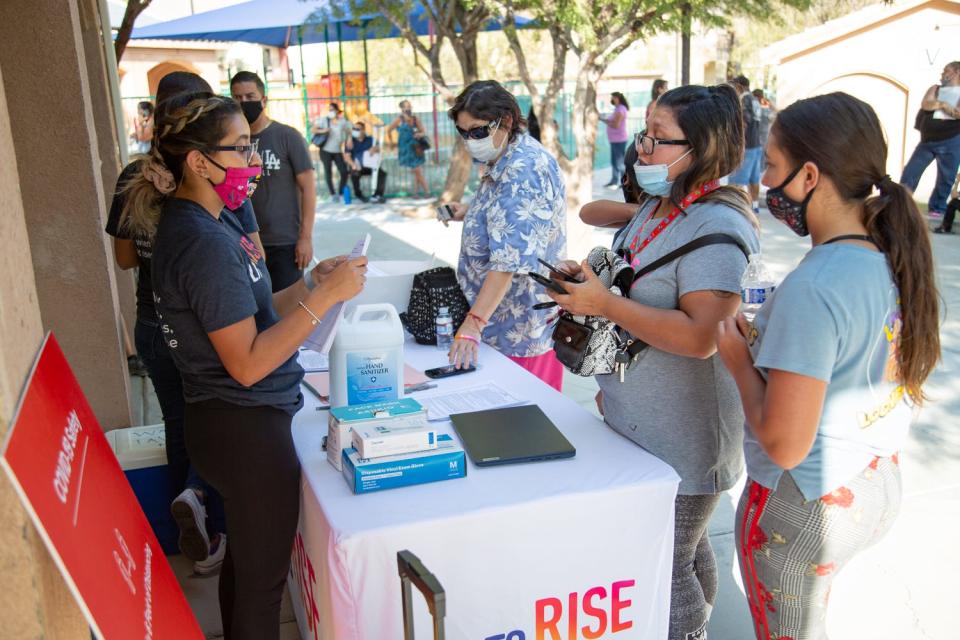'I would probably be homeless': Report evaluates United Lift rental assistance program
Cathedral City resident Teresa Perez felt like her world was crumbling around her during the height of the COVID-19 pandemic.
She lost her job as a community liaison at a local school district (which she did not want to name) once schools shut down in March 2020. The pandemic also brought tragedy to the 47-year-old's life, with the death of her parents, as well as the end of a romantic relationship. She added that she had to seek mental health help to cope with anxiety.
Throughout all the difficulties in her life, she tried to keep up with her monthly rent of $1,800 and do her best to provide for her three teenage children. However, she started getting behind in payments.
"I was left alone with my children, not having any saving. Everything was gone," she said. "And then United Lift came along."
The COVID-19 pandemic put financial strain on many people in Riverside County, but paying rent was already an issue for many resisdents before the virus. As a result of the uncertain times, Riverside County, together with nonprofits Inland SoCal United Way and Lift to Rise, launched an Emergency Rental Assistance program called United Lift Rental Assistance.

Funding for United Lift came from The Coronavirus Aid, Relief, and Economic Security (CARES) Act dollars and Emergency Rental Assistance funding, which was part of the larger American Rescue Plan Act funding package. Under CARES, approved applicants received one-time payments of up to $3,500, or the amount of their unpaid rental balance if that balance was less than $2,500. State and federal ERA funds also allowed United Lift to provide several months' worth of rental/utility assistance for missed payments and/or future ones.
The program provided direct rent and utility assistance between June 2020 and November 2022 and distributed more than $300 million countywide to over 35,000 households, or 120,000 residents, according to a new report released Wednesday.
For Perez, it meant five months of rental assistance and help with her electricity and gas bills in 2021.
"If it wasn't for United Lift, I would probably be homeless right now," she said.
Researchers in the USC Price School of Public Policy contracted with United Lift to evaluate the program, which included surveys and interviews with landlords and tenants throughout the county, and provide suggestions for other rental assistance programs. There were 2,452 tenants and 338 landlords surveyed.
The full report can be found at lifttorise.org/app/uploads/2023/03/USCxUnitedLift_FullReport.pdf
The program has also garnered attention from the state, housing and equity advocates and even the White House. A virtual panel to discuss the findings was held Wednesday with Gene Sperling, senior advisor to President Joe Biden, California Department of Housing and Community Development Director Gustavo Velasquez, Riverside County housing officials and Lift to Rise President and CEO Heather Vaikona. Lift to Rise is a Coachella Valley nonprofit focused on promoting housing policy and development. It operated United Lift in the eastern portion of Riverside County.
"We all sort of knew during the pandemic that we were doing something that was really uniquely special," Vaikona said. "We recognized from the beginning is that this work was so incredibly hard and complex. To be focused and determined to braid so many different types of federal, state and local resources, to mind very complex Treasury guidelines, to work 18 hours a day when there were no vaccines and we didn't know what was happening. But we all were driven by that same sense that we knew we were removing harm from our neighbors' lives."
Findings from the survey
Ian Gabriel, director of data, policy and planning for Lift to Rise, said people could apply for the program online, in-person, over the phone or during pop-up events. Applicants were then assigned a case manager, who followed up with them on the status of their application, requested additional paperwork and got in contact with landlords or utility companies.
To be eligible for assistance, renters in Riverside County were required to have earnings at or below 80% of the county area’s median income and have a documented loss of income due to COVID-19. Priority was given to households with incomes less than 50% of the area median income, and those with one or more adults who were not employed during the 90 days prior to submitting their application. Gabriel said the program's approval rate was around 60%.

Single people were disproportionately likely to apply for county assistance, making up 59% of applicants, while single parents consisted of 44%, according to the USC report. Nearly half of applicants were ages 25 to 44, and women overwhelmingly (nearly 63%) applied for the program. The racial and ethnic breakdown of applicants was 32% Hispanic, 22% white, 19% Black and 3% Asian.
Nearly 47% of applicants reported "extremely low-income," earning below 30% of the area median income. About 17% and 15% reported having full-time or part-time employment, respectively. Gabriel said the most common jobs were in food service, hospitality, casinos, health care and agriculture.
Paying for rent was most respondents' top financial priority, even over other bills. Nearly 90% of the respondents reported being unable to afford rent when they applied for the United Lift program, and 20% reporting rent increases. Black respondents reported higher rates of eviction and rent increases than other racial groups.
Vaikona said she and her team were "not surprised by anything we learned" from applicants or the survey. Even before 2020, she said two-thirds of people in Riverside County and the Coachella Valley struggled to pay their rent. Once the pandemic hit, even more were affected by job loss and reduction in income, making the burden to afford housing even greater.
She added that many single-parent-headed households are single Black or brown mothers.
"When you think about who is really hoisting this low-wage hospitality economy, it isn't really what I think folks think," Vaikona said. "It's incredibly hardworking women with children who are working two and three jobs."
Other information from the report shows those that had received assistance had better housing outcomes. During two survey waves (December 2021 to April 2022 and July 2022), those that had not received assistance had higher rates of homelessness, being doubled-up (sharing residence with another family), residential instability (having moved) and having received an eviction notice. Respondents used a range of strategies to cover rent, such as seeking assistance from family and friends, using savings, paying rent with a credit card or taking out a loan.
Surveyors who had received rental assistance were more likely to rate their health as very good or excellent and reported better mental health outcomes compared to those who did not receive financial help.
Among landlord findings, the survey showed they were more likely to be male (53%), white (45%) and 45 or older. About 75% manage or own single-family properties or townhouses.
The problems that landlords faced increased significantly during the pandemic, with the greatest being tenants not paying rent (80% for small landlords and 79% for non-small landlords). Others included filling vacancies, paying operating expenses or mortgages and issues with tenants, such as behavioral problems or lease violations.

Among the most difficult aspects of the program, Vaikona said, was navigating constantly shifting guidelines from federal or state sources of funding, such as the number of months rent could be covered or ways to prove applicants were impacted by the pandemic financially. But United Lift stayed "adaptive and flexible," she said, which is why she believes the state, White House and other agencies "have lifted up our program."
Sperling said of the program: "The United Lift partnership is one of the most innovative and successful national models for eviction prevention and helping hard-pressed renters and their families. The Biden Administration implemented the first-ever national eviction prevention strategy, helping eight million hard-pressed renters and their families. I'm grateful to the USC Price School for their excellent evaluation of this innovative partnership that can be one the nationwide models going forward."
'It was getting kind of scary'
Prior to the pandemic, Frank Elmore, 77, of Desert Hot Springs, was doing community work that he loved and felt was important.
He did contract work with the Palm Springs Unified School District's Family Engagement Center, where he had an after-school program and worked with Black youth. It didn't bring in a lot of money, he said, but it kept him busy, allowed him to help improve children's learning skills and helped him pay for rent and other bills.
But when schools switched to distance learning in 2020, Elmore's program was put on pause.
"That diminished the little income that I was getting, but it was big enough of a loss that it affected my financial obligations," Elmore said, who also earns Social Security income.
During an assignment at a Desert Hot Springs school site, he learned about the United Lift program. He went through the necessary steps to get an appointment and submitted an application, but it took some time for him to get a response.
At that same time, "it was getting kind of scary for me," he said, noting that he wasn't able to afford his $616 rent for a few months. He later received a notice from his apartment complex office that "sounded so threatening and so immediate and so intimidating" that he was fearful he would be evicted.
He endured that anxiety for about two months before United Lift's approval came through, the Desert Hot Springs resident said. He received nearly $3,700, which covered missed rental payments from October to December 2021 and future payments through March 2022.
Though Elmore is still financially challenged, he said he feels better about paying his rent, which recently increased to $665. He added that he is "getting very skilled at manipulating funds" to make ends meet for groceries and other bills.
He is also hoping to do further work with the school district and is currently pursuing a contract.

Because of the rental assistance program, Perez said she was able to catch up on money that she owed, and once she started working again in July 2022, she could start paying back people who loaned her funds. She also helped connect friends, family members, neighbors and school district parents to United Lift if they needed assistance.
While she is feeling "a little bit of relief" these days, it's still tough to make ends meet given inflation and high rental costs. Perez said she earns $2,100 per month from her job, while her rent is $1,800. To earn some more money, she provides childcare in the evenings and occasionally helps out at a friend's restaurant on the weekends. "There's no way you can save money," the Cathedral City resident added.
Through her work in the school district, Perez also sees continuing financial impacts many families face. Some are homeless, and she feels hopeless trying to connect them to community resources which are often times already strained. Other parents are "barely making it" and struggle to provide food and other necessities for their families. Children, as a result, are "not mentally ready to learn anything."
"I really pray and wish they can bring the (United Lift) program back," she said.
Lessons learned
While there were many successful aspects of United Lift, Lift to Rise leaders recognize there are improvements that needed to be made and can apply to other assistance programs in the future.
Gabriel said the guidelines that were attached to funding sources were "limiting program access to some of the hardest-to-reach populations in our region." Lift to Rise and United Way were later able to "advocate to both and state and federal governments," he continued, "to change regulations to allow for more trust of community members and expand program access to as many people as possible."

There were also a large population of renters who weren't applying to the program, but the nonprofits knew there was a need among them. As a result, they brought services to them via various pop-up community events and helped fill out applications for those who did not have access to the internet or had trouble doing it themselves.
The USC report also recommended identifying which geographic areas have the highest need for offline resources and increasing outreach in specific areas.
Reflecting on United Lift, Vaikona said she and others "learned how strong and resilient the folks in our community are to endure such difficult circumstances on a daily basis." But most importantly, they saw what was possible "when you choose to work together toward a common goal."
"Ten, 20, 30 years from now, we'll look back and say, 'What did we do during that time when everything was falling apart?' We chose to stick together and figure out, in spite of the obstacles, how to build and scale a program that, in the end, exceeded anyone's expectations," Vaikona said.
Ema Sasic covers entertainment and health in the Coachella Valley. Reach her at ema.sasic@desertsun.com or on Twitter @ema_sasic.
This article originally appeared on Palm Springs Desert Sun: New report evaluates United Lift COVID rental assistance program

